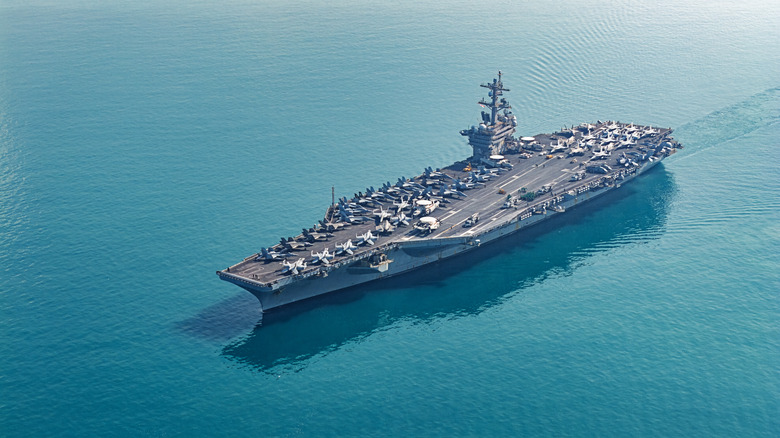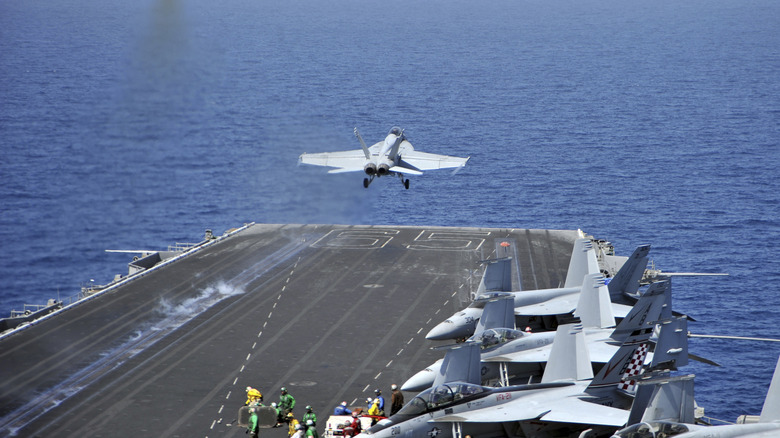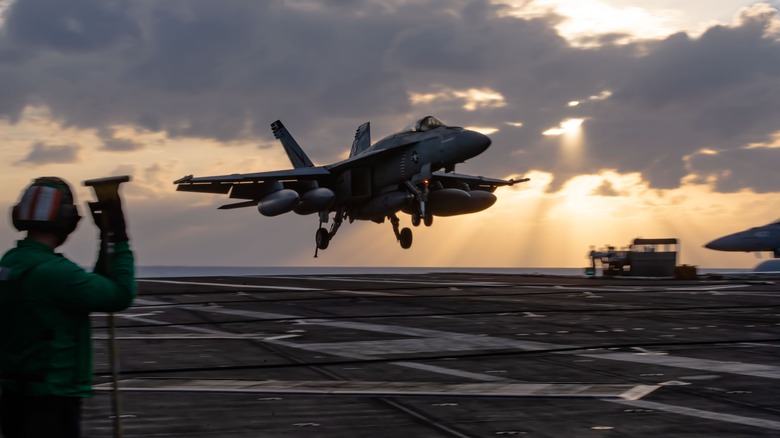Why Do Aircraft Carriers Face The Wind During Flight Operations?
Aircraft carriers are capable of launching and recovering jets in some of the most challenging environments on Earth. But the one thing that doesn't seem to make a whole lot of sense to outsiders: why do they always turn into the wind before an aircraft takes off or comes in for a landing? The short answer: physics. The slightly longer version: the physics of flight. As a matter of fact, facing into the wind only makes things safer and more efficient.
Think about what you know about lift. This is a force generated as air flows over the wings of an aircraft. For a successful liftoff, the plane has to reach a minimum airspeed relative to the surrounding air. When an aircraft takes off into a headwind, the effective airflow over its wings increases, giving it more lift at lower speeds. It's not unlike how a helicopter takes off nose-down.
On an aircraft carrier, the runway only measures around 300 feet. By turning the ship into the wind, you increase the airspeed across the flight deck, in turn allowing jets to lift off with less engine power over a much shorter distance.
Bernoulli's principle explained
As Bernoulli's principle argues: If you increase the velocity of fluid (or air) around an object, you also decrease the pressure. As an aircraft accelerates into oncoming winds,the curved top of the wing creates a region of lower pressure above it and higher pressure below it. This difference in pressure is what ultimately produces lift. By facing the wind, the carrier is essentially giving the aircraft a running start by generating this pressure differential on the runway before the plane even begins to accelerate.
The massively heavy aircraft carrier is also contributing to the headwind. By sailing into the wind at speeds as high as 30 knots, the aircraft carrier uses its own velocity to the planes' advantage: It makes the "wind over deck" that much stronger. For example, if the wind is blowing at 5 knots and the carrier is moving into it at 25 knots, the resulting wind across the deck would be 30 knots.
Landing is also done facing the wind
Landing on an aircraft carrier is just as technically demanding as takeoff. The deck is barely longer than a football field and constantly moving with the sea, and that's before you even account for wind. And, with Bernoulli's principle in mind, flying with the wind means you'll be coming in for a landing much faster than against it. But with a headwind on approach, you can slow down the aircraft's ground speed and cut down on the distance needed to stop.
This makes it easier for the pilot to "catch a wire," or snag one of several arresting wires stretched across the flight deck, with the aircraft's tailhook. These wires are connected to hydraulic systems below deck, and they can bring a massive aircraft traveling at top speeds to a screeching halt on that tiny little runway. Without a headwind, the aircraft would increase their likelihood of overshooting the deck entirely.
Even if there's no wind, the ship will create some. Before a takeoff or landing, the ship's course is adusted — as is its speed in knots – to make sure there's a consistent headwind across the flight deck. Lookouts, navigators, and radar operators maintain a full situational awareness while orders move from the bridge to the engine room to the rudder control. This complex choreography makes sure that, whether winds are strong or at a standstill, the pilot gets the best possible environment for a safe landing.


